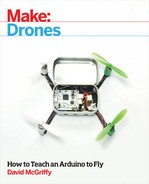Chapter 25. The Future
As futuristic as a current drone performing a completely autonomous flight might seem, most people agree that we are only at the beginning. There may yet be new breakthroughs that change the game, breakthroughs like in the motors, batteries, and control systems I described in Chapter 1 as making drones possible. Battery technology seems like one place where radical changes might happen. But we will stay on safer ground, or perhaps in safer skies, here by only asking where current trends might take us.
Specialization
Already an aerial photography drone looks different from a racing drone. If and when we have delivery drones, those will surely be a different breed again. Just as today we have several well established categories of cars (economy car, pickup, sports car, off-road vehicle, etc.), I would expect there to be several established categories of drones.
Just as today few people could tell you how many horsepower the engine in their car can produce, many categories of drone will simply do a job with performance measured by one or two obvious numbers, like flight time. Then, as with the car hot-rodders, there will be certain groups who know every last thing about their drones, who are constantly trying to find the best combination of components and programming.
I would, however, expect one aspect of drone flying to move toward standardization rather than specialization: the controls by which we fly them. Just as cars have the pedals in the same places and traditional aircraft have standard instrument layouts, I hope that the different manufacturers and control system communities will adopt some common human interface standards. I think the names and precise definitions of several standard flight modes could be common. Safety would be increased if safety features like the safety switch in our big drone got used the same way in every flight stack.
Ease of Use
The trend toward ease of use in drones has taken place mostly in the mid- to large-sized drones so far, because these have the payload capacity to carry the new technology. As that technology becomes more common and more highly integrated, it should make its way into smaller and smaller drones.
An easier-to-fly drone translates to a safer drone. If the controls are too complex, then mistakes are more likely. There are commercial jobs that drones can do, but if someone has to go practice hundreds of hours to learn to fly them, it’s not gonna happen.
The educational possibilities for drones will be opened up as they become easier to fly, too. Just think what kids could do with a drone that could be sent on autonomous missions with an interface as fun as Lego Mindstorms! The lesson, like the job, is more likely to succeed when the reward is more immediate.
On the other hand, I hope there will always be a place for piloting skill as well. Drone racing is fast becoming a popular spectator sport. The pundits already debate whether race car drivers are athletes in the same sense as runners. I wonder if a guy sitting in a lawn chair with goggles on twiddling his thumbs on some sticks will count? In his head he’s going a hundred miles an hour!
Safety
As we saw in Chapter 23, drones have been getting steadily safer, with features like sensor redundancy and failsafe systems. I certainly hope this trend continues with recovery parachutes and fully redundant power systems and controllers, and that we handle failures ever more gracefully.
As the number of drones increases year by year, we will be forced to keep making our drones safer if we want to be allowed to keep flying them. If drones are to be allowed to fly over people, just as traditional aircraft fly over our cities every day, then the risk of a drone crashing must be much lower than most drones in the air today can claim.
I believe we will learn to build a class of drone that can be safely flown in and around people. People fly their drones close to people all the time now, regardless, so this will be good for everyone, pilots and bystanders alike.
Human Flight
Every so often, a new story shows up where someone or some company has strapped enough drone technology together to be able to carry a human. Sadly, I have to say that most of them look like a bad idea. I have already commented on the number of single points of failure in today’s drones. This can be reduced by redundancy, but actually designing control systems where human life is at risk starts much further back than that.
When designing for human safety, you start with the management processes. If you don’t know what you are doing, how will you know that you are doing it right? Redundancy and fault tolerance in the narrow sense that we discussed earlier certainly play a part. Specialized analysis techniques like failure mode and effects analysis (FMEA) or testing techniques like hardware-in-loop (HIL) testing allow the systems to be validated before they are actually built. These things will come to drones. Already HIL testing and simulation can be done using certain ground control station software.
Driverless cars that carry humans share the road with us now. Our small, remotely or autonomously piloted drones will need to share the sky with larger, traditional aircraft as our numbers grow. We may not be there yet, but I can imagine the day when some convergence of drone and conventional aircraft technology lets me take off in my own multirotor. I can’t wait!
